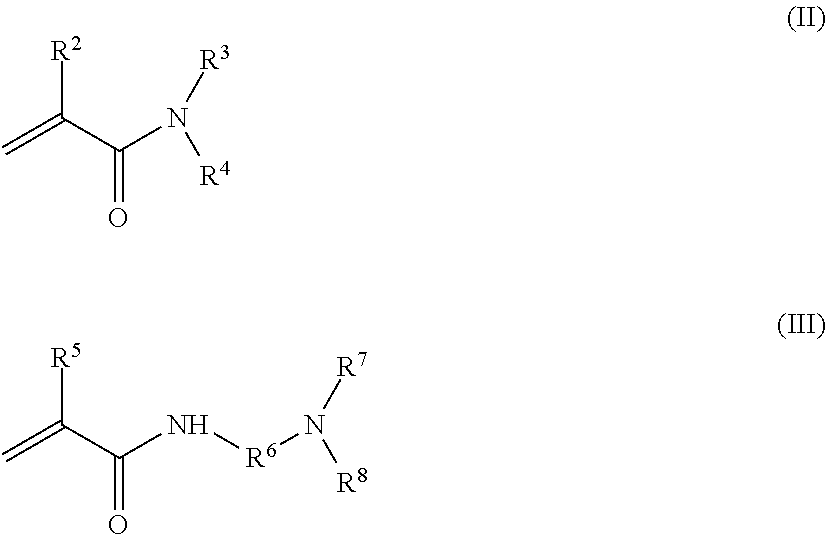Improved foaming performance in cleansing compositions through the use of nonionic, amphiphilic polymers
a technology of amphiphilic polymers and cleansing compositions, which is applied in the direction of detergent compositions, detergent compounding agents, hair cosmetics, etc., can solve the problems of reducing foam volume, harsh skin and eye irritation, and cleansing compositions containing higher levels of surfactant tend to be harsher in terms of eye and skin irritation, so as to improve the foaming performance and mild cleansing effect of anionic surfactant containing compositions
- Summary
- Abstract
- Description
- Claims
- Application Information
AI Technical Summary
Benefits of technology
Problems solved by technology
Method used
Image
Examples
examples 1-9
Polymer Synthesis
[0256]A free radical initiated dispersion polymerization is utilized to prepare the nonionic, amphiphilic polymer component of the invention. The polymerization reactor consists of a water-cooled resin kettle equipped with a reflux condenser, nitrogen purging tube, a mechanical agitator and a thermal-couple connected to a temperature control module. Admixtures of monomers, crosslinkers, and processing aids set forth in Table 1 are added to the resin kettle, followed by the polymerization solvent. The quantities of these components in wt. % for the various polymer preparations are shown in the table. While the reaction medium is heated to the target polymerization temperature, the reactor is purged with nitrogen for at least half an hour. As the reactor temperature reaches the set polymerization temperature, typically at about 67° C., the initiator solution 2,2′-azobis(2-methylbutyronitrile) (0.12 wt. % based on the dry weight of the polymer) is injected into the rea...
example 10
[0257]Two-in-one conditioning shampoos containing the crosslinked, nonionic, amphiphilic polymers prepared in accordance with Examples 1-8 are formulated with the components set forth in Table 2.
TABLE 2AmountComponentActive (wt. %)PART AD.I. Waterq.s. to 100Powdered Dispersion PolymerTable 3Sulfochem ™ ES-2 CWK anionic surfactant14Chembetaine ™ C amphoteric surfactant3PART BJaguar ® C13-S cationic guar deposition aid0.25PART CDow Corning ® silicone emulsion (DC 2-1352)2Glydant ® Plus preservative0.22PART D0.25NaOH (18% aqueous wt. / wt.) pH adjusting agentq.s. to pH 6
[0258]The shampoo compositions are prepared in accordance with the following procedure:
Part A:
[0259]1) Homogeneously disperse the polymer in D.I. water;
2) Add anionic and amphoteric surfactants and mix for 15 min.
Part B:
[0260]3) Prepare a 2 wt. % (wt. / wt.) dispersion of cationic guar in D.I. water and mix with Part A components.
Part C:
[0261]4) Add Part C components to Part AB component mixture and mix until homogeneous;
4)...
examples 11-14
[0263]Two-in-one conditioning shampoo containing the crosslinked, nonionic, amphiphilic polymer containing the polymer of Example 9 are prepared in accordance with the method set forth in Example 10 utilizing the components and amounts presented in Table 4. Identical comparative shampoo compositions are similarly formulated with a commercially available Carbomer rheology modifier. Carbomer was chosen as a benchmark as it is widely used to provide rheology and prevent silicone creaming in commercial shampoo formulations (see U.S. Pat. Appin. Pub. No. 2013 / 0039875; U.S. Pat. No. 5,034,218; European Pat. Appin. No. 0 463 780; and European Pat. No. 0 951 277 B1). A level of 0.4 wt. % Carbomer was chosen, as it is known in the art, and from the preceding disclosures, that this concentration can prevent silicone creaming in a shampoo formulation. The formulations are analyzed on the SITA Foam Tester to determine the amount of foam generated in accordance with the foam volume test methodol...
PUM
| Property | Measurement | Unit |
|---|---|---|
| wt. % | aaaaa | aaaaa |
| particle size | aaaaa | aaaaa |
| size | aaaaa | aaaaa |
Abstract
Description
Claims
Application Information
 Login to View More
Login to View More - R&D
- Intellectual Property
- Life Sciences
- Materials
- Tech Scout
- Unparalleled Data Quality
- Higher Quality Content
- 60% Fewer Hallucinations
Browse by: Latest US Patents, China's latest patents, Technical Efficacy Thesaurus, Application Domain, Technology Topic, Popular Technical Reports.
© 2025 PatSnap. All rights reserved.Legal|Privacy policy|Modern Slavery Act Transparency Statement|Sitemap|About US| Contact US: help@patsnap.com



